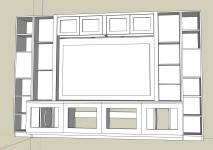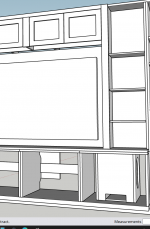I am building an wall unit for TV and audio, and one set of cabinets will be the bottom of a three way that will essentially be subs (but may extend a bit into woofer frequencies depending on testing & where I decide to put the XO.) The other 2 in the 3 way are 8" Scan 22W/4534g woofer into an SB26ADC tweeter in an AugerPro waveguide. This will all be playing into an open concept living room / dining room / kitchen type space that is nearly 1000 sq ft. and a total nightmare for audio (hardwood floors, smooth ceiling, hardwood shutters.) I got what concessions I could in terms of WAF, and this is where I ended up.
Current plan for the bottom end is 2xSB34NRXL opposed on each side, but have not yet bought the woofers yet, so driver is flexible. The 2 ways on top are currently built as large bookshelf style speakers until I get this thing built and then they'll build into the solid panel in the outer bookshelves as seen in the "innie" picture. There is a ~7" deep cavity behind the TV that hides approx 250L / 9cu ft per side after taking into account the bracing. Plan is to build with a port tuned to 16-18Hz and have the option to experiment with both ported and sealed configurations. Each side is powered by a Hypex FA253, so I can use the DSP to tune in the FR for an F3/F6/F10 much lower than the natural tuning.
I can build these in an "innie" or "outie" configuration (see pictures). Both have similar outward facing manifold area per speaker, and both will be covered by grille cloth so that aesthetics are not a part of the equation. I can get the drivers braced together better & the slot port is easier to build in the "outie" config, but the "innie" config seems like it would be the traditional way to build a manifold like this.
Will it make much of a difference either way? Is there a compelling reason to build it one way or another outside of how well the drivers are coupled together? Both variants can use threaded rod through both drivers, but in the "outie" config I can also brace the magnets together.
Current plan for the bottom end is 2xSB34NRXL opposed on each side, but have not yet bought the woofers yet, so driver is flexible. The 2 ways on top are currently built as large bookshelf style speakers until I get this thing built and then they'll build into the solid panel in the outer bookshelves as seen in the "innie" picture. There is a ~7" deep cavity behind the TV that hides approx 250L / 9cu ft per side after taking into account the bracing. Plan is to build with a port tuned to 16-18Hz and have the option to experiment with both ported and sealed configurations. Each side is powered by a Hypex FA253, so I can use the DSP to tune in the FR for an F3/F6/F10 much lower than the natural tuning.
I can build these in an "innie" or "outie" configuration (see pictures). Both have similar outward facing manifold area per speaker, and both will be covered by grille cloth so that aesthetics are not a part of the equation. I can get the drivers braced together better & the slot port is easier to build in the "outie" config, but the "innie" config seems like it would be the traditional way to build a manifold like this.
Will it make much of a difference either way? Is there a compelling reason to build it one way or another outside of how well the drivers are coupled together? Both variants can use threaded rod through both drivers, but in the "outie" config I can also brace the magnets together.
Attachments
Last edited:
The one thing people seem to be not aware of is the television set itself.
Not knowing the brand/type, all I can say about it is that flat-screen types, like LCD, are prone to vibration from nearby bass speakers.
By this I mean the screen/panel itself can suffer video distortion, compromising the viewing, which can be annoying.
If you take some sets screen, and tap its surface with your knuckle in various areas, you might notice the picture (or test screen) distort, or produce a flash-like effect.
The same can happen if a heavy bass sound of sufficent intensity is produced nearby by a subwoofer(s).
Being in the same cabinet with subs may be an issue.
That's why they make bass "shakers" installed under seating to give the same bass effects, but away from the tv.
Not knowing the brand/type, all I can say about it is that flat-screen types, like LCD, are prone to vibration from nearby bass speakers.
By this I mean the screen/panel itself can suffer video distortion, compromising the viewing, which can be annoying.
If you take some sets screen, and tap its surface with your knuckle in various areas, you might notice the picture (or test screen) distort, or produce a flash-like effect.
The same can happen if a heavy bass sound of sufficent intensity is produced nearby by a subwoofer(s).
Being in the same cabinet with subs may be an issue.
That's why they make bass "shakers" installed under seating to give the same bass effects, but away from the tv.
Maybe it's just me, but if a guy ever had a chance to hide a pair of basshorns, this is it. It's not just that, but your room itself is large enough to allow some LF to form. Suggest a dig into 50's and 60's audio rags for "built-ins" before you commit to geometry (unless it's already done).
Wiseoldtech:
1) The design of the bottom end in an opposed config was primarily to reduce vibration. TV vibration is less of a concern to me than the vibration of all the whatever that will end up on the shelves. Damping the shelves is a larger concern, but everything will have some level of damping, including the TV mount.
2) This is also built on newly constructed addition to the house and I let my builder know there would be an entertainment center and subs here. It has extra cross bracing of the floor joists and wall studs in this area of the house to accommodate. Walls and floor are finished at this point.
I know 1 & 2 won't stop all of the vibration, but it should help to minimize it. Again this is a balance of what I could get in terms of WAF.
3) Movie / TV 20Hz bass is not the goal, these will be 2.0... no LFE channel. Good music bass is the goal, so TV vibration should matter a lot less than designing the shelves so they don't rattle.
4) TV is OLED, which, I think, should have less susceptibility to the image distortion you are describing, since it's all one filmstack and doesn't have LCD layer + backlight that can flex differently when mechanically loaded.
1) The design of the bottom end in an opposed config was primarily to reduce vibration. TV vibration is less of a concern to me than the vibration of all the whatever that will end up on the shelves. Damping the shelves is a larger concern, but everything will have some level of damping, including the TV mount.
2) This is also built on newly constructed addition to the house and I let my builder know there would be an entertainment center and subs here. It has extra cross bracing of the floor joists and wall studs in this area of the house to accommodate. Walls and floor are finished at this point.
I know 1 & 2 won't stop all of the vibration, but it should help to minimize it. Again this is a balance of what I could get in terms of WAF.
3) Movie / TV 20Hz bass is not the goal, these will be 2.0... no LFE channel. Good music bass is the goal, so TV vibration should matter a lot less than designing the shelves so they don't rattle.
4) TV is OLED, which, I think, should have less susceptibility to the image distortion you are describing, since it's all one filmstack and doesn't have LCD layer + backlight that can flex differently when mechanically loaded.
Last edited:

